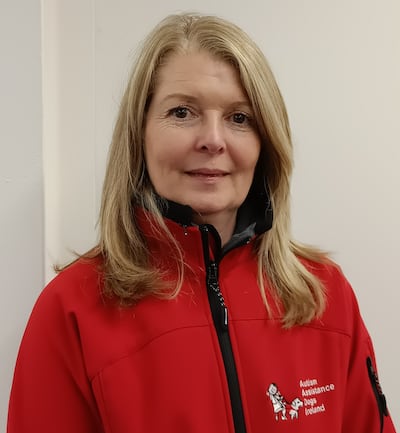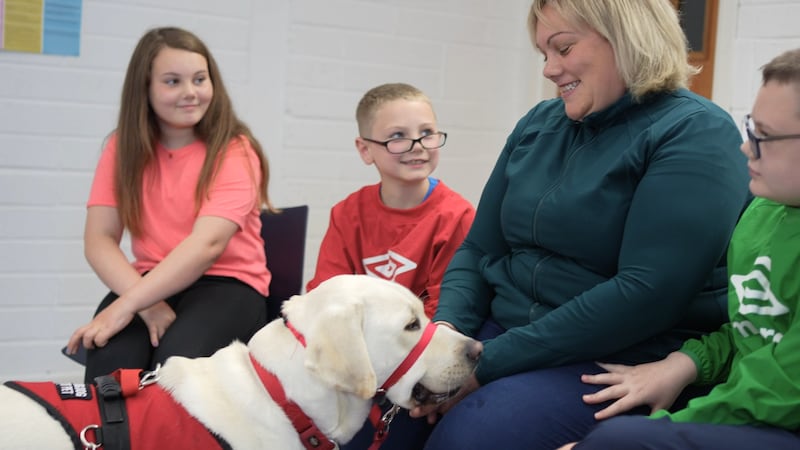Dependable and loyal, dogs race through childhood memories and are an excuse for solitary, late-night strolls by adult owners. But some dogs perform a vital function for children and families affected by autism.
Guide dogs are excellent facilitators for people with partial sight. While assistance dogs are different, they are no less transformative for the safety of some children who, as a result of autism, may tend to suddenly bolt. Families with such “flight-risk” kids have been helped by Autism Assistance Dogs Ireland (AADI), an organisation based in Little Island, Cork.
The sensory world of some child with autism can be a kaleidoscope of sounds and images that trigger anxiety. A force field of stimuli, which might otherwise intrigue or excite, can prompt a little boy or girl to run off – potentially into the path of danger. The sound of a fridge in a shop. An alarm. A flashing light. Any unexpected thing. This is where the assistance dog serves as an emotional and physical lifesaver.
Mary Ellen Kingston is a mother of three children, each on the autism spectrum. “I have left shops in tears without getting what we need, as Alan (7) tried to bolt as I held on to him,” she says. “But, since we got Kane, life has improved enormously.”
READ MORE
Inspired by pioneering work done in Canada, the AADI in 2010 began introducing assistance dogs to Ireland – buying, breeding and training dogs. Through foster trainers, trainers and other staff, the AADI invites applications for dogs from families and allocates them nationwide according to pragmatic but compassionate guidelines. “The child must be a flight risk,” says Nuala Geraghty, chief executive. “They have to be a runner who absconds from the parent when out in a public place – where the parent has to hold the child’s hand. This is our criteria for allocating the dogs. It is the parent who holds on to the lead. The child is attached via a belt to the dog and the parent gives the commands. The dogs are fully trained to walk nicely on the lead, to do left and right turns, to behave in social situations. They have really good recall.”

The voyage of a dog to the heart of a family home is a long one. The dog trains as an “undergraduate” for 12 months, after which it undertakes a “postgraduate” course of six months. Pups are selected on grounds of health and disposition. Many get weeded out in the year of foster family training – for reasons such as strength, disposition and obedience. The final half-year polishes a qualified canine elite into an officer class. They become trustworthy and efficient. Personality, learning ability and command obeisance interact with the dog’s personality, and “sense” to create a positive agent of change. X-rays of hips to confirm canine robustness are just part of this stringent programme.
I often sat for half an hour whereas we had them done in two mins the other day. He was calm and patting Kane
Martin Falvey is a dog trainer with AADI. He explains how Ireland has gone from early adaptor of assistance dogs to a global exemplar. Organisations come from all over Europe to see how things are done here. Dog training involves exposure to everyday situations – supermarkets, butcher shops, the park, being demure with other dogs, travelling by car and public transport. The goal is a solid dog who resists canine temptations and dedicates itself to the needs of a child. While the role is as a mobile anchor, Falvey speaks of ancillary benefits which often arise. “One girl would talk to the dog about her day at school rather than to her parent and she alluded to bullying. We only guarantee the bolting function. But I have seen dogs go and sit with a child and calm them. Another benefit is permitting one parent have their hands free to help another child pick flowers or whatever.”
Dog handover also belongs to the trainer’s remit. Once selected, parents attend a weeklong training programme in managing, looking after and bonding with their dog. After five days, they return to their child with a new infrastructural family member who will make a world of a difference.
Assistance dogs are very scarce. Training is expensive. The AADI is at the mercy of donors and funding sources stretched by an uncertain economy. Mary Ellen waited for seven years for Kane to arrive, even as her first child grew older. She is philosophical, believing all good things come to you. The transformative and functional joy Kane brought is evident. “Since we have had Kane, we have had dentist trips, been in and out of hospitals. Getting bloods done for Jack (11) the other day, Kane put his head on his lap and there was no hassle. Before, you couldn’t hold him to get them done. I often sat for half an hour whereas we had them done in two mins the other day. He was calm and patting Kane.”
We were stuck in a very dark tunnel and Kane has given us light
This is a long way from being overwhelmed and walking out of shops, purchases incomplete, to burst into tears.
Kane instils comfort and security. “Overall anxiety has reduced for all three. Plus myself. Just getting out of the house and into the car was a struggle. We’d avoid any appointment we could or going places. You would be dealing with what you would face when you got home.” The family recently completed a 5km walk together – a binding exercise of which Ellen-Marie (10) and her brothers are proud. “During the training with Martin Falvey and Ciara Fleming, everyone was so helpful. They are an amazing team. They have given us a new start. For families out there waiting, keep the faith. Their day will come. They will get their life-changing assistance dog.
“We were stuck in a very dark tunnel and Kane has given us light. The freedom to get back out into the world and a new beginning. He is the best thing that ever happened to us.”

Assistance dogs: stats
- Dogs currently in training: 14
- Dogs graduating at year end: 6
- Cycles of training per year: 2
- Families requesting dogs each year: 1,000
- Families initially selected: 300
- Lottery selection from these: 35
- Weekly cost to sponsor a dog in training: from €3
- People are desperate to get on the waiting lists. A webinar session for 300-500 families is held from which the selection lottery is based. Dogs are delivered 18 months later.
“We could supply 100 dogs a year and still not meet demand. Our long-term vision is to have our own purpose-built centre in Cork to train dogs and parents. We need more trainers, puppies, breeding dogs, money. We are trying to raise €100,000 by the end of 2022. This would cover the final six months of training, the matching process and the family coming for training.” – Nuala Geraghty, chief executive of AADI














